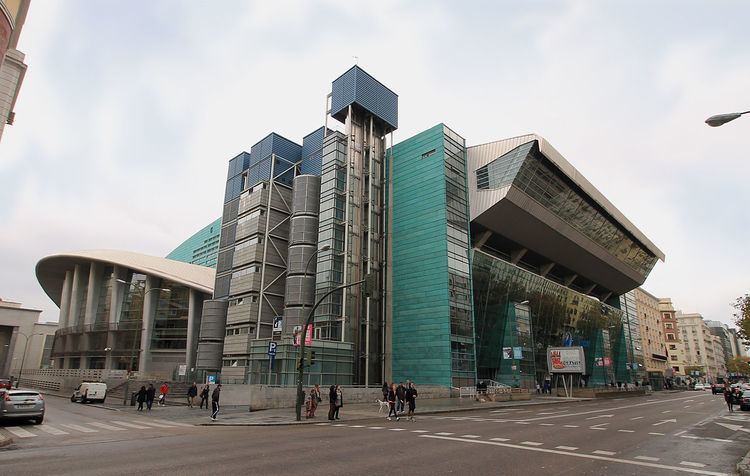Closed 2002–2005 | Opened 1960; 2005 Construction cost € 124 million Phone +34 914 44 99 49 | |
 | ||
Former names Palacio de Deportes de la Comunidad de Madrid(until 2014)Barclaycard Center(2014–2016) Capacity 15,000 (basketball)15,500 (concerts) Address Av. Felipe II, S/N, 28009 Madrid, Spain Similar Palau Sant Jordi, Palacio Vistalegre, Las Ventas, Sala Caracol, Caja Mágica Profiles | ||
Beatles y stones dani mart n y rayden palacio de deportes de madrid 23 05 2014
Palacio de Deportes de la Comunidad de Madrid (English: Community of Madrid Sports Centre), since November 2016 called WiZink Center for sponsorship reasons, is an indoor sporting arena located in Madrid, Spain. Its capacity is 15,000 people for basketball matches and 15,500 for concerts (with standing public ramp).
Contents
- Beatles y stones dani mart n y rayden palacio de deportes de madrid 23 05 2014
- Origins 18741960
- First venue 19602001
- Rebuilt venue 2005present
- References
The former building, which was built in 1960, was destroyed by a fire in 2001. Architects Enrique Hermoso and Paloma Huidobro projected a High-Tech style new arena that was built at the same place between 2002 and 2005.
The arena hosted two major international basketball events in the first decade of the 21st century. It hosted the knockout stage of EuroBasket 2007, and the following year hosted the EuroLeague's Final Four 2008. It also hosted three times the final stage of the Copa del Rey of basketball in 2006, 2009 and 2011.
The arena was the final's venue for the 2014 FIBA Basketball World Cup and the Euroleague Final Four 2015.
Origins (1874–1960)
Until the late 19th century, the area where the Sports Centre was an area of orchards on the perimeter of the city, in Goya street below, the edge of the extension that had been done at the behest of Marques de Salamanca. In 1872 the then mayor of Madrid, the Count of Toreno, laid the foundation stone of a new bull ring, since the old, located next to the Puerta de Alcalá, was demolished for the construction of new neighborhood. Two years later, on 4 September 1874 opened the square style was neomudéjar and was designed by architects Álvarez Lorenzo Capra and Emilio Rodríguez Ayuso.
Due to increasing population of the city and the great love of bullfighting existing in Madrid, the square was small and 1931 opened a new arena, the Monumental Sales next to Abroñigal stream. For three years the new plaza was virtually unused, so it continued to hold bullfights in the former. The last was held on 14 October 1934. A week later, on 21 October, was formally inaugurated the Plaza de Las Ventas. La Plaza de Goya street history of the Palace of Sports was demolished a few days later.
The site remained empty for years given the state of penury in which the country found itself after the Civil War and the postwar years. Finally, 1952, Mayor José María Gutiérrez del Castillo promoted the construction of an indoor arena such as already exist in other European capitals. In 1953 a competition was held for the completion of the palace. In 1956 the National Sports Delegation, Opted for the project by architects José Soteras and Lorenzo García Barbon, authors Palacio de los Deportes de Barcelona opened a year ago to host the Mediterranean Games held in the city.
First venue (1960–2001)
The project of the Sports Palace was a circular building 115 m in diameter, built of reinforced concrete and metal sheath. The work cost 56 million pesetas.
The original capacity was 10,000 to 16,000 depending on the configuration of grades and activities that develop inside. Thus, for example, to test the capacity cycling was 10.609 and 16.137 boxing bouts.
The palace was inaugurated in 1960. In 1969 it was expanded with basketball courts, cycling, hockey and athletics. In 1985 ownership of the Palace was transferred to the Comunidad de Madrid, who undertook a comprehensive reform of the building.
During the 41-year life of this first Palacio de los Deportes gathered inside a number of sports competitions: basketball, athletics, boxing, handball, martial arts, cycling and gymnastics as well as equestrian, skating, hockey and up trial. Hosted the Real Madrid of 1986 until 1998 and students of 1987 to the fire.
On June 28, 2001, the Sports Centre suffered a fire and was in ruins.
Rebuilt venue (2005–present)
After the fire, the Comunidad de Madrid decided to build a new building in the same place. It was designed by architects Enrique Hermoso and Paloma Huidobro. Its construction was started February 20 of 2002 with a budget of 124 million euros. He took advantage of the former building of the structure, particularly the facade of the Plaza de Salvador Dalí and Avenida de Felipe II and the back of the Calle Fuente del Berro. It was inaugurated February 16 of 2005 by Mayor Alberto Ruiz-Gallardón and the president of the Community of Madrid Esperanza Aguirre. It has a variable capacity depending on the configuration to be adopted:
